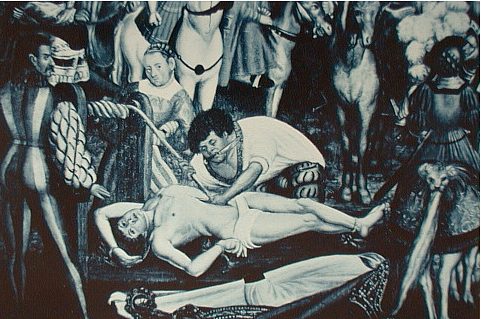- Erasmus of Formiae
Infobox Saint
name=Saint Erasmus of Formiae
birth_date=3rd century
death_date=c. 303
feast_day=June 2 ["Martyrologium Romanum" (Libreria Editrice Vaticana, 2001 ISBN 88-209-7210-7]
venerated_in=Roman Catholic Church 
imagesize=300px
caption="The Martyrdom of Saint Erasmus"
birth_place=
death_place=Illyricum (modern dayCroatia )
titles=Holy Helper
beatified_date=
beatified_place=
beatified_by=
canonized_date=
canonized_place=
canonized_by=
attributes=represented by awindlass [ [http://www.catholic-forum.com/saints/sainte05.htm] ]
patronage=sailor s,Gaeta ,Formia ,colic in children, intestinal ailments and diseases,cramp s and the pain of women in labor,cattle pest,Fort St. Elmo , (Malta)
major_shrine=
suppressed_date=
issues=Saint Erasmus of Formiae is a
Christian saint and martyr who died ca. 303, also known as Saint Elmo. He is venerated as thepatron saint ofsailors . St Erasmus or Elmo is also one of theFourteen Holy Helpers , saintly figures of Christian legend who were venerated especially inCentral Europe as intercessors.Documentation of his life
The "Acts of Saint Elmo" were partly compiled from legends that confuse him with a Syrian bishop Erasmus of Antioch.
Jacobus de Voragine in the "Golden Legend " credited him as a bishop atFormia over all the ItalianCampania , as a hermit onMount Lebanon , and a martyr in the persecutions underEastern Roman Emperor Diocletian .Account of life and martyrdom
According to his legend, when the persecutions of the Emperor Diocletian began, "Erasmus was called before a judge, beaten around the head, spat upon and 'besprinkled [...] with foulness.' He was then beaten with leaden mauls until his veins broke and burst. Erasmus suffered all of these punishments with tremendous willingness. Erasmus was then thrown into a pit of snakes and worms, and boiling oil and sulfur were poured on him but 'he lay therein as he had lain in cold water, thanking and loving
God .' Then thunder and lightning came and electrocuted everyone around save Erasmus. Thus the saint was protected from thelightning . Diocletian had him thrown in another pit, but an angel came and slew all the vipers and worms."Then came the
Western Roman Emperor Maximian who, according to Voragine, was "much worse than was Diocletian." Erasmus would not cease preaching the Gospel, even though he was "put into a pan seething with rosin, pitch, brimstone lead, and oil, [which were] pour [ed] ... into his mouth, [from] ... which he never shrinked." A searing hot cloak and metal coat were both tried on him, to no effect, and an angel eventually carried him away to safety.""And when this holy man came before the false gods" - to which he was to be forced to sacrifice, they "fell down and broke all in pieces, and consumed into ashes or dust." That made the emperor so angry he had Erasmus enclosed in a barrel full of protruding spikes, and the barrel was rolled down a hill. But an angel healed him. Further tortures ensued:"
"His teeth were ... plucked out of his head with iron pincers. And after that they bound him to a pillar and carded his skin with iron cards, and then they roasted him upon a gridiron...and did smite sharp nails of iron in his fingers, and after, they put out his eyes of his head with their fingers, and after that they laid this holy bishop upon the ground naked and stretched him with strong withes bound to horses about his blessed neck, arms, and legs, so that all his veins and sinews that he had in his body burst."
The version of the "Golden Legend" did not relate how Erasmus fled to Mount Lebanon and survived on what
raven s brought him to eat, an interesting pre-Christianmytheme . When he was recaptured, he was brought before the emperor and beaten and whipped, then coated with pitch and set alight (as Christians had been inNero 's games), and still he survived. Thrown into prison with the intention of letting him die of starvation, St Erasmus managed to escape.He was recaptured and tortured some more in the Roman province of
Illyricum , after boldly preaching and converting numerous pagans to Christianity. Finally, according to the legend, his stomach was slit open and his intestines wound around awindlass . This late legend may have developed from interpreting an icon that showed him with a windlass, signifying his patronage of sailors.Veneration and patronage
Saint Erasmus may have become the patron of sailors because he is said to have continued preaching even after a thunderbolt struck the ground beside him. This prompted sailors, who were in danger from sudden storms and lightning to claim his prayers. The electrical discharges at the mastheads of ships were read as a sign of his protection and came to be called "Saint Elmo's Fire". [ [http://www.catholic.org/saints/saint.php?saint_id=182 St. Erasmus(St. Elmo)] at Catholic online]
Pope St Gregory the Great recorded in the 6th century that his relics were preserved in the cathedral of Formia. When the old "
Formia e" was razed by theSaracen s in 842, the cult of Erasmus was translated toGaeta . He is currently the patron of both Gaeta and Formia.Besides mariners, Erasmus is invoked against
colic in children, intestinal ailments and diseases, cramps and the pain of women in labor, as well as cattle pest.References
Gallery
ee also
*
St. Elmo Hall , a name for some chapter houses of Delta Phi fraternity
*St. Elmo's Fire , a meteorological phenomenon named after the saint
* BlessedPeter Gonzalez , patron of Spanish and Portuguese mariners is also invoked as "San Telmo" or "San Elmo."External links
* [http://www.catholic-forum.com/saints/golden350.htm "The Golden Legend (Saint Erasmus)"] – e-text adapted from
Wynken de Worde 's edition of 1527.
* [http://www.saintpatrickdc.org/ss/0602.htm Saint Patrick's Cathedral profile on Saint Erasmus]
Wikimedia Foundation. 2010.
